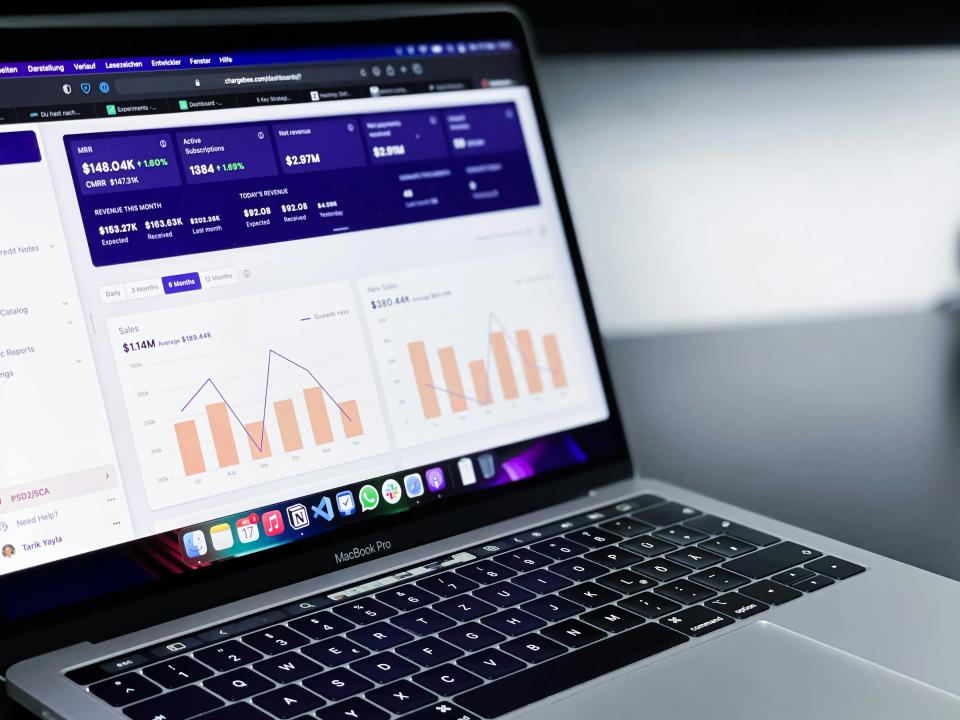That sinking feeling in your gut. You’ve just launched a brilliant new campaign, pouring your budget, creativity, and high hopes into it. But as the days turn into weeks, the results are… vague. You see clicks, you see impressions, but you can’t feel the pulse of real growth.
Now, imagine the opposite. Imagine launching a campaign with the calm confidence of a surgeon, knowing every dollar is precisely allocated. Imagine watching your metrics climb, not by chance, but by design. This isn't a fantasy; it's the power you gain when you stop guessing and start measuring.
This post is your guide to that transformation. We will move beyond vanity metrics and dive into the essential data-driven digital marketing tools and techniques that forge a direct path to tangible success and a powerful ROI. At CaptivateClick, data is the bedrock of every strategy we build, turning bold ideas into predictable, profitable outcomes.
What is Data-Driven Digital Marketing?
Let’s cut through the jargon. Data-driven marketing is the practice of using hard facts about your customers—their behaviors, their preferences, their actions—to make smarter, faster, and more profitable marketing decisions. It’s the definitive end of marketing by committee and the beginning of marketing with conviction. You stop throwing things at the wall to see what sticks and start building a machine engineered for results.
The benefits are not just incremental; they are transformative. Data-driven organizations are a staggering 23 times more likely to acquire customers than their peers, according to McKinsey. This isn't about small wins; it's about fundamentally changing the game in your favor.
This approach empowers you to achieve:
- Personalization at Scale: Deliver messages so relevant they feel like a one-on-one conversation.
- Optimized Budget Allocation: Put your money where it generates the highest return, eliminating waste.
- Improved Customer Experience (CX): Understand user friction and create seamless digital journeys.
- Enhanced ROI: Make every decision a direct contributor to your bottom line.
This is the core of creating measurable marketing strategies—turning abstract goals into concrete achievements through the intelligent application of digital marketing analytics.
Essential Data-Driven Digital marketing Tools for 2024
Are you equipped for this new reality? The right tool depends on your specific goal, but a formidable marketing stack covers the entire customer journey, from first glance to final conversion. Having the right instruments isn't just an advantage; it's the price of entry for modern success.
Website & User Behavior Analytics
Your website is your digital storefront, and you need to know exactly what happens when people walk through the door. The first step is to install tools that give you both the "what" and the "why" of user behavior. This is where raw numbers meet human psychology.
The undisputed cornerstone of web analytics is Google Analytics 4 (GA4). Its event-based model allows you to gain deeper insights into user behavior across every platform, mapping the entire customer journey instead of just isolated sessions. To complement this, tools like Hotjar or Microsoft Clarity are essential for uncovering behavioral patterns that numbers alone can't explain. With heatmaps and session recordings, you can literally watch where users click, get stuck, and ultimately, what convinces them to act. For a deeper look at this process, explore our guide on leveraging data-driven insights for UI/UX design.
SEO Performance Tracking
You can have the best product in the world, but it means nothing if your customers can't find you. Dominating search engine results requires constant vigilance and powerful intelligence. You need to know what your competitors are doing, how your site is performing, and where your next big opportunity lies.
Comprehensive platforms like Semrush and Ahrefs are the all-in-one command centers for search engine optimization. They allow you to track keywords, analyze backlinks, and conduct technical audits to inform on-page and technical SEO strategies. Alongside these, the non-negotiable free tool is Google Search Console. It is your direct line to Google, essential for monitoring and maintaining a website’s presence and understanding your site's health through metrics like Core Web Vitals. To ensure your site's foundation is solid, review these technical optimization tools every digital marketer should use.
Paid Advertising (SEM) Analytics
Paid advertising is like pouring fuel on a fire—it can create explosive growth or burn through your cash with nothing to show for it. The difference is data. Success in SEM isn't about spending more; it's about spending smarter, and that requires a granular understanding of performance.
Within Google Ads Performance Reports, you must look beyond simple clicks to analyze conversion data, Quality Score, and auction insights to truly maximize ROI. Similarly, Meta Ads Manager provides the detailed analytics needed for developing measurable marketing strategies on Facebook and Instagram, allowing you to dissect performance by audience, creative, and placement. For a real-world example of this in action, see how we approach harnessing Google Ads for global brand expansion.
CRM & Email Marketing Analytics
Your email list and customer database are goldmines of potential revenue. Every interaction, from an email open to a purchase, is a data point that can inform your next move. This is where you build relationships and nurture leads toward conversion with surgical precision.
Platforms like HubSpot and Mailchimp are critical for tracking the metrics that matter: open rates, click-through rates, and, most importantly, conversions. Their powerful segmentation and automation features allow you to convert prospects into customers through highly targeted campaigns. According to Campaign Monitor, segmented campaigns can drive a massive 760% increase in revenue, proving that personalization pays. To apply these principles effectively, explore our advanced email marketing automation strategies for B2B lead nurturing.
Key Techniques to Unlock Measurable Marketing Success
Having the best tools is only half the battle. A world-class hammer can’t build a house on its own; it needs the hands of a skilled carpenter. The following techniques are how you wield your data tools to construct a powerful, predictable growth engine.
Technique 1: A/B and Multivariate Testing
Stop debating and start testing. A/B and multivariate testing is the scientific method for marketing, allowing you to pit one version of your ad copy, landing page, or call-to-action against another in a head-to-head battle for supremacy. This is how you replace "I think this will work" with "I know this works."
The process is simple but profound. You can test a red button versus a green one, a bold headline versus a subtle one, or a short email versus a long one. Each test provides a clear winner, allowing you to make incremental improvements that compound into massive gains over time. For a step-by-step guide, don't miss our post on mastering conversion optimization from visitor analysis to actionable A/B testing.
Technique 2: Customer Segmentation
Are you speaking to everyone the same way? If so, you're failing to connect with anyone. Customer segmentation is the art of dividing your audience into smaller, distinct groups based on their behavior, demographics, or purchase history so you can deliver hyper-personalized messages.
Imagine creating a specific campaign just for users who abandoned their shopping carts, offering them a small discount to complete their purchase. Or targeting high-value customers with an exclusive sneak peek at a new product. This is how you make your audience feel seen and understood, dramatically increasing engagement and loyalty. See how this technique is applied in our guide to cold email outreach for generating B2B leads.
Technique 3: Marketing Attribution Modeling
Which marketing channel gets the credit for a sale? The first ad a customer saw, or the last one they clicked? Marketing attribution modeling is the technique that answers this crucial question, helping you understand the customer journey comprehensively.
Without proper attribution, you might mistakenly cut the budget for a channel that plays a vital role early in the buying process. By moving beyond a simple "last-touch" model, you gain a true understanding of how all your channels work together to drive conversions. This insight is fundamental to optimizing your budget and scaling what truly works.
Technique 4: Creating a Data Feedback Loop
Data-driven marketing is not a one-time project; it is a continuous cycle of improvement. The most successful marketers live by a simple, powerful framework that creates a perpetual feedback loop. This is the engine of relentless optimization.
The process is a constant rhythm of action and analysis. You must commit to this cycle to ensure your strategies evolve and improve over time, staying ahead of competitors and adapting to market changes. The framework is simple:
Measure -> Analyze -> Optimize -> Repeat
This is the strategic process we use at CaptivateClick to deliver continuous growth for our clients. To learn more about putting this cycle into practice, read our guide on leveraging analytics for continuous website optimization.
Conclusion: Make Every Click Count
Drowning in spreadsheets is not the goal. Gaining absolute clarity is. Data-driven marketing strips away the uncertainty and replaces it with a clear, actionable path to growth.
By combining the right tools like Google Analytics 4 and Semrush with powerful techniques like A/B testing and customer segmentation, you can finally build the measurable marketing strategies you've been striving for. You can stop hoping for results and start engineering them. The journey to data mastery is iterative, so start today. Focus on one key metric, implement one new technique, and build your confidence from there.













